ISSN: 2320-2459
ISSN: 2320-2459
Wim Vegt*
Department of Industrial Engineering and Innovation Sciences, Eindhoven University of Technology, Eindhoven, Netherlands
Received: 26-Sep-2022 Manuscript No. JPAP-22-76022; Editor assigned: 28-Sep-2022 Pre QC No. JPAP-22-76022(PQ); Reviewed: 12-Oct-2022, QC No. JPAP-22-76022; Accepted: 19-Oct-2022, Manuscript No. JPAP-22-76022(A) Published: 26-Oct-2022, DOI: 10.4172/2320-2459.10.6.004.
Visit for more related articles at Research & Reviews: Journal of Pure and Applied Physics
In general relativity, the interaction between gravity and light fundamentally has been based in quantum light theory on the gravitational-electromagnetic interaction. Instead of a curved space-time continuum in general relativity, the curved path of a beam of light within a gravitational field in quantum light theory has been based on the interaction between the gravitational field and an accelerated electromagnetic field e.g., the curved path of a beam of light, deflected by a black hole, in which the beam of light is generating its own gravitational field by its own acceleration. The deflection of a beam of light by the gravitational field of a black hole is a pure example of gravitational-gravitational interaction between two independent gravitational fields. In Quantum Light Theory (QLT) the electromagnetic energy gradient creates through a second order Lorentz transformation the gravitational field, which determines the interaction force density between the confinements of Light GEONs, gravitational electromagnetic confinements, published by John Archibald Wheeler in 1955 and a second gravitational field. In this way the property for GEONs of mass has been generated by its own gravitational field. A valuable way to test theories describing the interaction between gravity and light is the phenomenon of gravitational redshift. The differences in result between measuring the gravitational redshift between an atomic clock in an ESA satellite in a Galileo orbit and a corresponding atomic clock at a ground station are smaller than 17 digits after the decimal point, between general relativity and quantum light theory.
Quantum light theory; Gravitational field; Electromagnetic field; Magnetic fields
When Isaac Newton walked out of the only opera he ever attended, music had a significant place in his work. As an undergraduate, Newton closely studied music in its quadrivial context during the crucial year in which he initially formulated his ideas about gravitation and physics. Much later, he used musical concepts to formulate his description of spectral colours by imposing a musical octave on the spectrum. In his studies of the colours of Newton’s rings, however, he observed that the spectral colours seem to span a major sixth, not an octave. He attempted to understand this in terms of cube roots and squares, reminiscent of Kepler’s third law in astronomy. By thus arguing away the troublesome discrepancy between an octave and a sixth, Newton did not allow himself to confront the importance of this discrepancy. This musical error may have kept him from realizing the degree of the relation between the wave theory of sound (which he had pioneered) and its application to light.
Quantum Light Theory (QLT) has been based fully on Isaac Newton’s concepts and early ideas about beauty, harmony and equilibrium. The most important concept in QLT is his third law. The law of equilibrium- Newton’s third law of equilibrium has been extended in QLT into a 4-dimensional equilibrium in which the equilibrium in time (the fourth dimension) represents the fundamental relativistic quantum mechanical “Dirac equation” which is a better presentation in quantum physics than the earlier presented Schrödinger equation which is only valid at relative low velocities.
Gravity is the interaction between two or more gravitational fields. In a comparable way like electric fields only interact with electric fields and magnetic fields only interact with gravitational fields. It is wrong to suggest that electric fields interact with magnetic fields. They do not interact and electric fields do not interact with gravitational fields. In the same way magnetic fields do not interact with gravitational fields.
By moving in space and time with a relative velocity v̅ Electric Fields interact with transformed magnetic fields by the relativistic Lorentz transformation into an electric field:

In which γ represents the relativistic time dilatation/Lorentz contraction term and E̅ represents the electric field intensity B̅ represents the magnetic induction.
By moving in space and time with a relative velocity v̅ , magnetic fields interact with transformed electric fields by the relativistic Lorentz transformation into a magnetic field:

By accelerating in space and time with a relative acceleration g̅, gravitational field interacts with transformed electromagnetic fields by the relativistic second order Lorentz transformation:

In which gEM̅ the gravitational field acceleration generated by the accelerated electromagnetic field, the poynting vector and ρEM̅ the specific electromagnetic mass.
Quantum light theory describes the quantization of confined light in electromagnetic radiation. An example of the quantization of confined light appears in the electromagnetic GEONs introduced by Archibald wheeler in 1955 [1]. The existence of GEONs has been based on electromagnetic gravitational interaction.
To describe the interaction between gravity and light, the Inertia (Mass) of light has to be included within the fundamental electromagnetic field equations, which describe classical electrodynamics. Maxwell’s equations do not include an Inertia term for light. For that reason a new fundamental electromagnetic equation has to be developed to describe the electromagnetic field (including Inertia and electromagnetic interaction) in a different and more complete way than Maxwell (Einstein called Maxwell the greatest physicist of his century) did. To develop a new electromagnetic theory, it is necessary to go back to the time of Isaac Newton, who published in 1687 in the “Philosophiae Naturalis Principia Mathematica” a universal fundamental principle in physics. The fundamental principle of harmony in the whole universe based on his religious and mathematical understanding of the creator of the universe. Newton expressed this harmony in the foundation of a universal equilibrium and he expressed the universal equilibrium in his third Law on which all physics has been built.
Newton’s approach to electrodynamics and electromagnetic interaction in quantum light theory
Newton found the concept of universal equilibrium which he formulated in his famous third equation action= - reaction (Newton’s third law). In nowadays math the concept of universal equilibrium has been formulated as:

Because the inertia force is a reaction force, the inertia force appears in the equation with a minus sign (Newton’s second law).

Equation (2) is a general presentation of Newton’s famous second law of motion. In a fundamental way, Newton’s second law of motion describes the required electromagnetic equation for the gravitational electromagnetic interaction in general terms, including Maxwell’s theory of electrodynamics published in 1865 in the article: A dynamic theory of the electromagnetic field and Einstein’s theory of general relativity published in 1911 the article: On the influence of gravitation on the propagation of light.
Because Maxwell’s 4 equations are not part of one whole uniform understanding of the universe like the fundamental equation of Newton’s second law of motion represents, Maxwell’s theory is missing the fundamental foundation. Newton’s second law of motion has been based on a profound understanding of the universe which is based on the fundamental principle of harmony and equilibrium, expressed in equation (1).
To realize the new gravitational electromagnetic equation, Newton’s second law of motion will be the universal concept in physics on which quantum light theory will be built. The fundamental electromagnetic force density equation has been based integral on Newton’s second law of motion and has been divided into 5 separate terms (B-1 until B-5), each one describing a part of the electromagnetic and inertia interaction force densities.

The first term B-1 represents the inertia of the mass density of light electromagnetic radiation. The terms B-2 and B- 3 represent the electric force densities within the electromagnetic radiation in beam of light and the terms B-4 and B-5 represent the magnetic force densities within the electromagnetic radiation in the beam of light.
Fundamental in the quantum light theory is the outcome of equation (3) which always has to be zero according Newton’s fundamental principle of universal equilibrium. To apply the concept of universal equilibrium within an electromagnetic field, the electric forces FElectric, the magnetic forces FMagnetic and the inertia forces will be presented separately in equation (3):

The first term (the inertia of light) in quantum light theory (Term B-1)
Albert Einstein’s general relativity describes the interaction between gravity and light. It is impossible to build a framework for the interaction between gravity and light without describing the Inertia (mass) of light. Because there can only be interaction between gravity and Inertia mass. Without Inertia mass there will be no interaction with gravity. The mass of light is very different than the mass of objects we usually describe. The mass inertia of objects is always Omni-directional. It does not matter in what for a position we put a mass on a scale. The weight interaction between gravity and the object will always be the same.
That is not the fact for light. A spherical beam of light has no mass. The mass inertia will occur when the electromagnetic energy density in the light changes. At the edges of light and no light darkness, the interaction between gravity and light will take place. For a laser beam the interaction between gravity and light will take place at the edges of the laser beam. For that reason a laser beam will be deflected by a gravitational field when it passes a large mass. But when a laser beam propagates towards or away from a black hole, the speed of light will not change because there is no gravitational electromagnetic interaction.
The result of interaction is a force. When a beam of light propagates towards the earth and will be partly absorbed and partly reflected the electromagnetic energy flux changes in direction partly becomes zero, and has been absorbed and Newton’s effect of F=ma becomes noticeable in a radiation pressure e.g. on the earth of a few ton.
Reducing equation (2) to one single force F̅, equation (2) will be written in the well-known presentation:

The right and the left term of Newton’s law of motion in equation (5) has to be divided by the volume “V” to find an equation for the force density related to the mass density “ρ”.
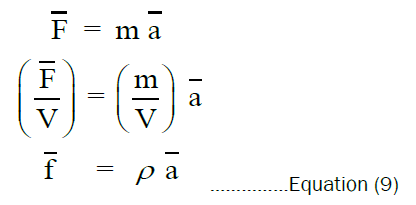
The inertia force  for electromagnetic radiation will be derived from Newton’s second law of motion, using the relationship between the momentum vectors p̅ for radiation expressed by the Poynting vector S̅:
for electromagnetic radiation will be derived from Newton’s second law of motion, using the relationship between the momentum vectors p̅ for radiation expressed by the Poynting vector S̅:

Dividing the right and the left term in equation (7) by the volume V results in the inertia force density 

The Poynting vector S̅ represents the total energy transport of the electromagnetic radiation per unit surface per unit time J/m2s which can be written as the cross product of the electric field intensity and the magnetic Field intensity H̅ .

Second and fourth term in quantum light theory (Term B-2 and B-4)
An example of the Coulomb force is the electric force FCoulomb acting on an electric charge Q placed in an electric
field  The equation for the Coulomb force equals:
The equation for the Coulomb force equals:

Dividing the right and the left term in equation (10) by the volume V results in the electric force density 
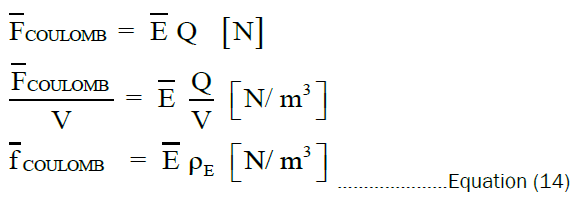
Substituting Gauss’s law in differential form in equation (11) results in Coulombs law for electromagnetic radiation
for the Electric force density 

In electromagnetic field configurations, there is in general no preference for the electric force densities or the magnetic force densities. In general the equations for the electric field densities are universally exchangeable with the magnetic field densities.
For the magnetic field densities, equation (12) can be written as:

Third and fifth term in quantum light theory (Term B-3 and B-5)
An example of the Lorentz force is the magnetic force FLorentz acting on an electric charge Q moving with a velocity v within a magnetic field with magnetic field intensity B and magnetic induction shown in Figure 1.
The equation for the Lorentz force equals:

Dividing the right and the left term in equation (14) by the volume V results in the Lorentz force density 

In which q is the electric charge, v the velocity of the electric charge, B the magnetic induction and j the electric
current density is substituting Ampère’s law in differential form in equation (15) results in Lorentz’s Law for
Electromagnetic Radiation for the Electric force density 

In electromagnetic field configurations, there is in general no preference for the electric force densities or the magnetic force densities. In general the equations for the electric field densities are universally exchangeable with the magnetic field densities. For the electric field densities, equation (16) can be written as:

Fundamental equation for electromagnetic interaction in quantum light theory (Term B-1+Term B- 2+Term B-3+Term B-4+Term B-5)
Newton’s second law of motion applied within any arbitrary electromagnetic field configuration results in the fundamental equation (23) for any arbitrary electromagnetic field configuration in a beam of light:

Term B-4 is the magnetic equivalent of the (electric) Coulomb’s law B-2 and term B-3 is the electric equivalent of the magnetic Lorentz’s law B-5.
The universal equation for the electromagnetic interaction for propagating electromagnetic waves in laser beam and confined electromagnetic waves has been presented in equation (19) and expresses the perfect equilibrium between the inertia forces (B-1), the electric forces (B-2 and B-3) and the magnetic forces (B-4 and B-5) in any arbitrary electromagnetic field configuration.

The integration of Maxwell’s theory of electrodynamics in quantum light theory
The fundamental equation for electromagnetic interaction in equation (19) for any arbitrary electromagnetic field configuration can be written in the form:

The Maxwell equations are presented in equation (21):

In vacuum in the absence of any electric or magnetic charge density, it follows from equation (21) that all the solutions for the Maxwell’s equations (21) are also solutions for the fundamental equation for electromagnetic interaction in equation (20) for the electromagnetic field.
Fundamental Equation for Electromagnetic Interaction
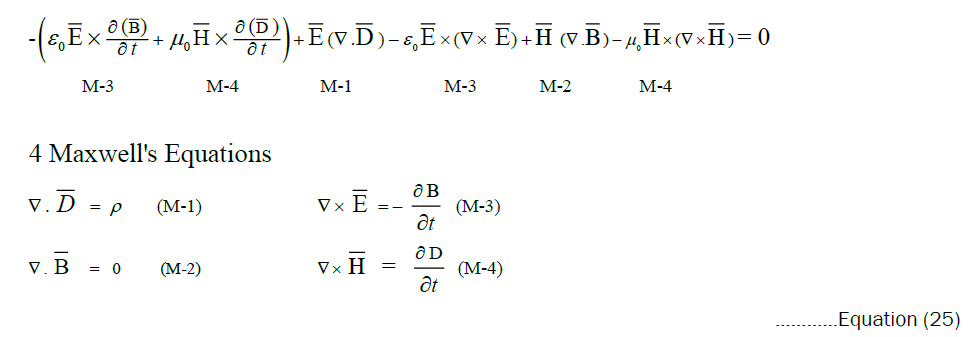
Comparing the 4 Maxwell equations (21) with the fundamental equation for electromagnetic interaction from equation (20) results in the conclusion that the 4 Maxwell equations show only the 4 parts of the fundamental equation for electromagnetic interaction in 4 separate terms and the 4 Maxwell equations are missing the fundamental term for inertia. For that reason it is impossible to calculate the interaction between light and gravity with the 4 Maxwell equations. To find the interaction terms between light and gravity the inertia term B-1 in equation (19) is necessary.
The quantization of light (In General Electromagnetic Radiation) in quantum light theory
In physics the quantization of light has always been related to the quantization of Einstein’s concept of photons. In quantum light theory the quantization of light has been related to a much broader concept also including wheeler’s concept of GEONs.
In general when waves have been confined, like a sound wave on a guitar string, the phenomenon of standing waves (stationary waves) appears with the well-known aspects of nodes and antinodes in all possible modes.
The equation in quantum light theory for confined electromagnetic waves is an equation for standing waves (stationary waves) which appear with the well-known aspects of nodes and antinodes in all possible modes, describing the quantization of electromagnetic radiation in GEONs [2].
Newton’s approach to the fundamental concept of quantum mechanical probability in quantum light theory
In a 4-dimensional notation of equation (35), the fourth term of Newton’s third law can be interpreted in quantum light theory as the law of conservation of energy. For an electromagnetic field the law of conservation of energy has been expressed as:

From the equation for the conservation of electromagnetic energy from equation (23) the fundamental equation for confined electromagnetic interaction in quantum light theory will be derived, which equals the relativistic quantum mechanical Dirac equation.
The fundamental equation for confined electromagnetic interaction in quantum light theory can be considered to be the relativistic version of the quantum mechanical Schrödinger wave equation, which equals the quantum mechanical Dirac equation.
The fundamental concept of quantum mechanical probability in quantum light theory
The physical concept of quantum mechanical probability waves has been created during the famous 1927-5th Solvay conference [3,4]. During that period there were several circumstances which came just together and made it possible to create a unique idea of Material Waves solutions of Schrödinger’s wave equation being complex partly real and partly imaginary and describing the probability of the appearance of a physical object elementary particle generally indicated as quantum mechanical probability waves.
The idea of complex probability waves is directly related to the concept of confined (standing) waves. Characteristic for any standing acoustical wave is the fact that the velocity and the pressure have electric field and magnetic field in QLT is always shifted over 90 degrees. The same principle does exist for the standing confined electromagnetic waves [5,6].
For that reason every confined electromagnetic wave can be described by a complex sum vector  of the electric field vector
of the electric field vector and the magnetic field Vector
and the magnetic field Vector has 90 degrees phase shift compared to
has 90 degrees phase shift compared to 
The vector functions  and the complex conjugated vector function
and the complex conjugated vector function will be written as:
will be written as:

 Equals the magnetic induction,
Equals the magnetic induction,  the electric field intensity
the electric field intensity  has+90 degrees and phase shift compared to
has+90 degrees and phase shift compared to  and c the speed of light.
and c the speed of light.
The complex conjugated vector function  equals:
equals:

The dot product equals the electromagnetic energy density w:

Using Einstein’s equation W=mc2, the dot product equals the electromagnetic mass density w:

The cross product is proportional to the Poynting vector in equation 15 [3].

Newton’s third law has been described for the electromagnetic field in 3 spatial dimensions, resulting in the fundamental equation for electromagnetic interaction in QLT:

The formal mathematical way to describe the force density results from the 4-dimensional divergence of the 4- dimensional energy momentum tensor, resulting in a 4-dimensional force vector. Dividing the 4-dimensional force vector by the volume results in the 4-dimensional force density vector.
The 4-dimensional electromagnetic vector potential has been defined by:

In which the term φa represents the 4-dimensional electromagnetic vector potential in the “a” direction while the indices “a” varies from 1 to 4. In a Cartesian coordinate system the indices are chosen varying from the x,y,z. Then magnetic potential A and t direction to electric potential “V”. In which the indices “t” represents the time direction which has been considered to be the 4th dimension. The 4-dimensional electromagnetic Maxwell tensor has been defined by:

Where the indices “a” and “b” vary from 1 to 4.
The 4-dimensional electromagnetic energy momentum tensor has been defined by:

The 4-dimensional divergence of the 4-dimensional energy momentum tensor equals the 4-dimensional force density 4-vector fa :

Substituting the electromagnetic values for the electric field intensity “E” and the magnetic field intensity “H” in equation (71) results in the 4-dimensional representation of Newton’s third law equation (1):
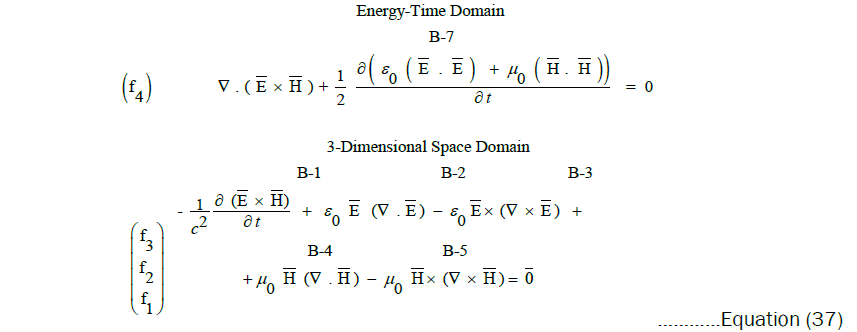
In which f1, f2 and f3, represent the force densities in the 3 spatial dimensions and f4 represent the force density energy flow in the time dimension (4th dimension). Equation (42) can be written as:
The 4th term in equation (42) can be written in the terms of the Poynting vector “S” and the energy density “w” representing the electromagnetic law for the conservation of energy in the Newton’s second law of motion.
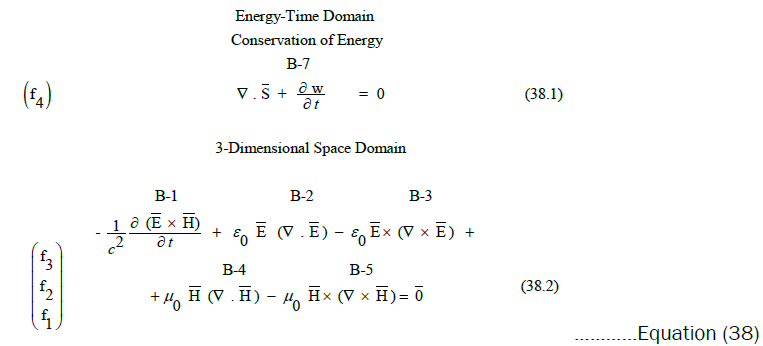
In quantum light theory the 4-dimensional fundamental equation for electromagnetic interaction equals the 4-dimensional relativistic quantum mechanical Dirac equation
Substituting equations (27) and (28) in equation (35) results in the 4-dimensional equilibrium equation (36):

To transform the electromagnetic vector wave function  into a scalar (spinor or one-dimensional matrix
representation), the Pauli spin matrices σ and the following matrices are introduced:
into a scalar (spinor or one-dimensional matrix
representation), the Pauli spin matrices σ and the following matrices are introduced:

Equation (36) can be written as the 4-dimensional relativistic quantum mechanical Dirac equation:

The fourth term (x4) equals the relativistic Dirac equation (38.1) which equals equation (102).
Equation (38.1) represents the relativistic quantum mechanical Dirac equation where represents the quantum mechanical probability wave function. The mathematical evidence for the equivalent for (38.1) has been published in 1995 in the article: a continuous model of matter based on AEONs. Equation (1) page 201 to equation (102) page 213. The electromagnetic law for the conservation of energy in equation (35) and the relativistic Dirac equation (38.1) are identical but written in a different form.
The law of conservation of electromagnetic energy can be written in an electromagnetic form in equation (39.1) or in an identical way in a quantum mechanical form (39.2):

The disadvantage in the quantum mechanical relativistic Dirac equation (39.2) is that the Dirac equation is a 1- dimensional equation which is not able to describe the 4-dimensional real physical world. While 39.1 represents an electromagnetic vector equation.
From the equations (27) and (28) follows the 4-dimensional vector-Dirac equation (40). This equation is a 4- dimensional vector equation and is coherent with the 4-dimensional physical reality.

In which the quantum mechanical complex probability Vector function and the complex conjugated vector function equals:

The 4-dimensional Dirac equations (38) and (40) represents the 4-dimensional Newtonian equilibrium in the 4- dimensional space-time continuum en has been represented by 4 separate equations. The first one represents the well-known relativistic quantum mechanical Dirac equation in the time-energy domain x4. This represents the energy equilibrium in the time-domain in conservation of energy. The 3 quantum mechanical equation in the spacemomentum domain represents the “Newtonian Equilibrium” for the force densities in the space domains (x1, x2, x3).
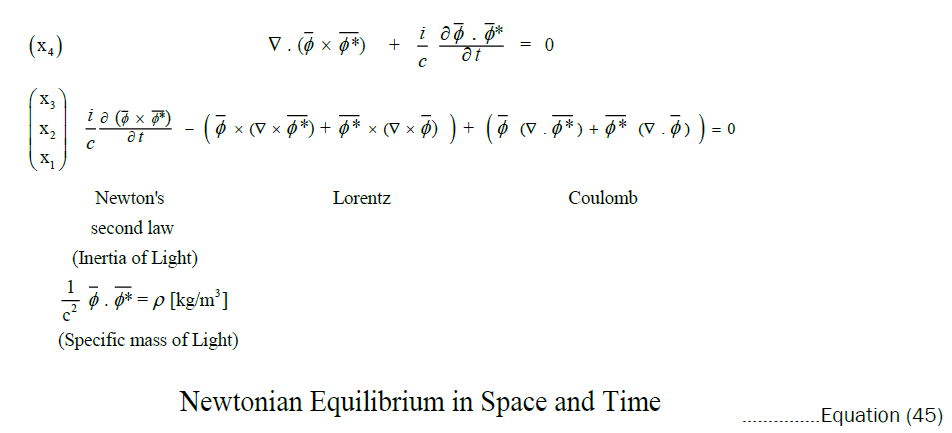
Equation (45) represents the Newtonian equilibrium in equation (1) in a 4-dimensional space-time continuum.
The 4-dimensional fundamental equation for electromagnetic gravitational interaction in quantum light theory
To define the fundamental equation for electromagnetic gravitational interaction, an extra term (B-6) has been introduced in equation (29). The term B-6 represents the force density of the gravitational field acting on the electromagnetic mass density.
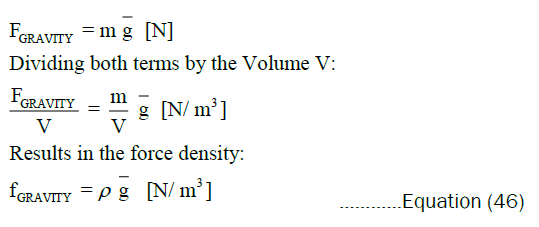
The specific mass “ρ” of a beam of light follows from Einstein’s equation:
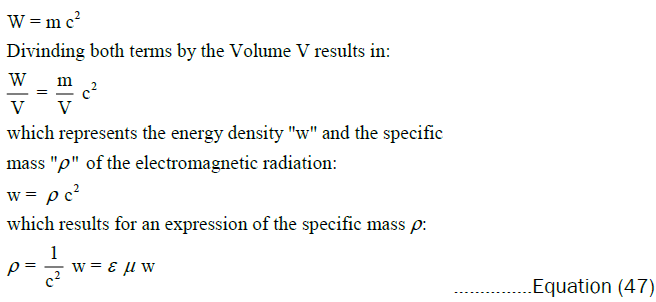
The energy density “w” follows from the electric and the magnetic field intensities:

Substituting equation (45) in equation (44) results in the gravitational force density fGRAVITY acting on an arbitrary electromagnetic field configuration (a beam of light with mass density ρ.

Substituting equation (46) in equation (29) results in the fundamental equation describing the electromagneticgravitational interaction for any arbitrary electromagnetic field configuration in a beam of light:

Term B-1 represents the inertia term of the electromagnetic radiation. Term B-4 is the magnetic representation of the electric coulomb’s force B-2 and Term B-3 is the electric representation of the magnetic Lorentz force B-5. Term B-6 represents the electromagnetic-gravitational interaction of a gravitational field with field acceleration acting on an arbitrary electromagnetic field configuration in a beam of light with specific mass ρ.
The universal equation for the electromagnetic field free electromagnetic waves and confined electromagnetic fields within a gravitational field with gravity field intensity has been presented in equation (48) and expresses the perfect equilibrium between the inertia forces (B-1), the electric forces (B-2 and B-3), the magnetic forces (B-4 and B-5) and the gravitational force (B-6) in any arbitrary electromagnetic field configuration.

Planck’s constant in quantum light theory
To describe the proportionality between energy and frequency of Planck’s constant for confined electromagnetic waves, an example has been chosen of an electromagnetic wave light confined between two 100 % reflecting mirrors.
Figure 2 represents confined electromagnetic radiation with amplitude E0 and frequency. A general property of confined electromagnetic waves is the proportionality between energy and frequency. As an example the confinement of light between two perfect reflecting mirrors with surface A has been chosen.
When both mirrors are being moved towards together of a distance, the work has been delivered:

In which “A” equals the surface of the mirrors and “p” equals the radiation pressure:

The electromagnetic work Δ W” which has been delivered equals:

When over a time “ Δ t ”one mirrors move towards the other with a velocity “v”, then the distance “Δx ” passed over a time interval Δt equals:
Δx = v Δ t (m) …………Equation (55)
Substituting equation (52) in equation (51) results in:

In which “W” equals the total energy involved in the transformation of Mechanical Energy into the Electromagnetic Energy. When an observer moves (relatively) towards a beam of light, a Doppler frequency shift appears:

The same happens for the moving mirror. A shifted frequency will be reflected. The total effect of the displacement of the distance Δx will be a frequency shift in the confined electromagnetic radiation which equals:
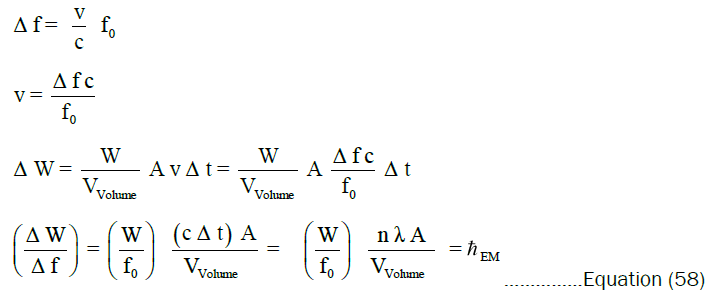
In which λ represents the wavelength of the confined radiation and “n” the number of wavelengths of compressions.
The term  represents an electromagnetic equivalent for Planck’s constant.
represents an electromagnetic equivalent for Planck’s constant.
The electromagnetic gravitational confinement of GEONs in quantum light theory
The physicist John Archibald wheeler, and well-known friend of Albert Einstein, published his theory about Gravitational Electromagnetic Entities (GEONs) in 1955 in Physical Review Journals: “GEONs”. John Archibald Wheeler was the first one in physics who understood (even better than Albert Einstein) that:

Quantum light theory refers in a certain way not only to Isaac newton but also to “Nikola Tesla” and his quotes: 1) If you wish to understand the universe, think of energy, frequency and vibration. 2) If you only knew the magnificence of the 3, 6 and 9, then you would have a key to the universe.
Wheeler’s conclusion was that every beam of light creates simultaneously a gravitational field, besides the original electromagnetic field, proportional to the electromagnetic energy of the beam of light.
Like a black hole can capture a beam of light, it is possible that a beam of light confines itself due to its own gravitational field forming a Gravitational Electromagnetic Entity (GEON). The final results of Wheeler’s research were not what he expected. He found only GEONs by toroidal gravitational electromagnetic confinement with the dimensions of a star constellation and a stable lifetime of a few milliseconds.
Quantum Light Theory presents new Gravitational Electromagnetic equation describing electromagnetic field configurations which are simultaneously the mathematical solutions for the quantum mechanical Schrodinger wave equation and more exactly the mathematical solutions for the relativistic quantum mechanical Dirac equation. The mathematical solutions for the gravitational electromagnetic equation carry mass, electric charge and magnetic spin at discrete values [7-9].
When a beam of light is approaching a strong gravitational field in the direction of the gravitational field, generated by a black hole, the confinement has been called a longitudinal black hole. The direction of propagation of the beam of light is in the same direction or in the opposite direction of the gravitational field. According the first term in equation (33), the beam of light will be accelerated or decelerated. However, the speed of light is a universal constant and for that reason the speed of light cannot increase or decrease. Instead the intensity of the electromagnetic radiation will increase when the beam of light propagates in the opposite direction as the direction of the gravitational field the black hole. And the intensity of the electromagnetic radiation will decrease when the beam of light leaves propagates in the same direction as the direction of the gravitational field the black hole [10].
The gravitational electromagnetic confinement for the elementary structure beyond the superstring/black hole is presented in equation (49).

In which g̅ represents the gravitational acceleration acting on the electromagnetic mass density of the confined electromagnetic radiation.
A possible solution for equation (49) describing a Gravitational Electromagnetic Confinement (GEON) within radial gravitational field with acceleration g̅ in radial direction has been represented in equation (50).

In which the radial function f(r) equals:

The solution has been calculated according newton’s shell theorem.
GEONs with an electromagnetic mass: emm=1.6726x10-27 kg and the radius=3x10-58 m
For an electromagnetic mass of the confinement: emm=1.6726x10-27 kg mass of proton, the radius of the confinement equals approximately 3x10-58 m. This is far beyond the order of Planck’s length.
The Plot graph of the electric field intensity f(r) of the confinement has been presented as a function of the radius in Figures 2-4.
The fundamental question is how it is possible to create confinements from visible light with a wave length between 3.9x10-7 m until 7x10-7 m within dimensions smaller than Planck’s Length?
This is only possible when the wave length of the confined radiation is smaller than de dimensions of the confinement. This requires extreme high frequencies. The transformation in frequency from visible light into the extreme high frequency of the confinement is possible because of the Lorentz/ Doppler transformation during the collapse (compression) of the radiation when the confinement has been formed (implosion of visible light). This has been presented in equation (55) during the compression of visible light with the electromagnetic equivalent for Planck’s constant [11-13].
A comparable effect becomes visible in the gravitational frequency shift red shift/blue shift. During the gravitational compression of the light, emitted by the observed star constellation, the frequency increases gravitational blue shift and during the gravitational expansion of the light the frequency decreases gravitational red shift.
The electric charge and the magnetic spin for electromagnetic GEONs in quantum light theory
The following functions for electromagnetic GEONs with the quantum variables (m1, n1, p1, q1) have been chosen:
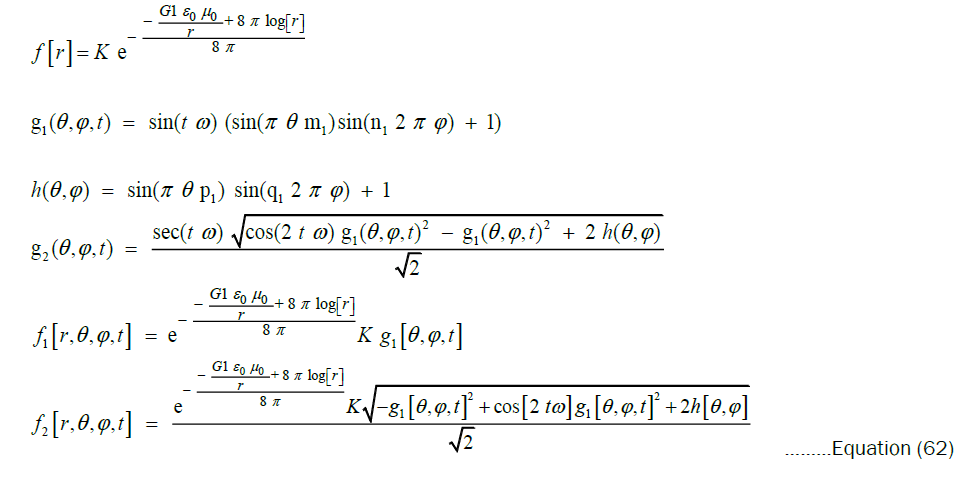
GEON with quantum numbers (Electric and Magnetic dipoles, Electric and Magnetic spin) (m1=0, n1=0, p1=0, q1=0)
The divergence of the electric field intensity (electric charge density) equals:
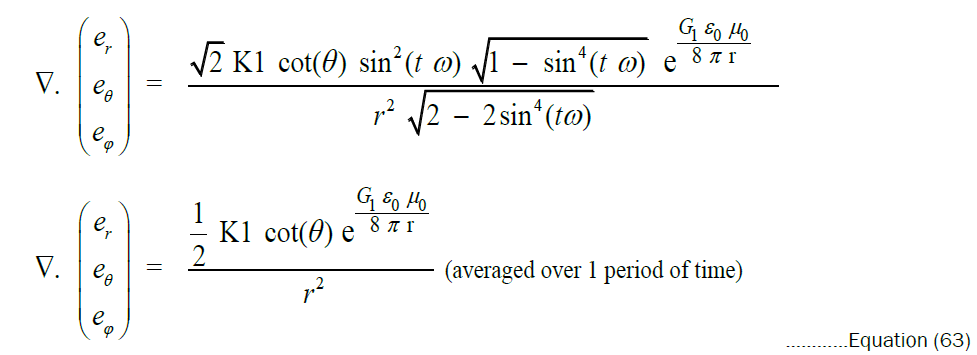
The divergence of the magnetic field intensity (magnetic monopole) equals:
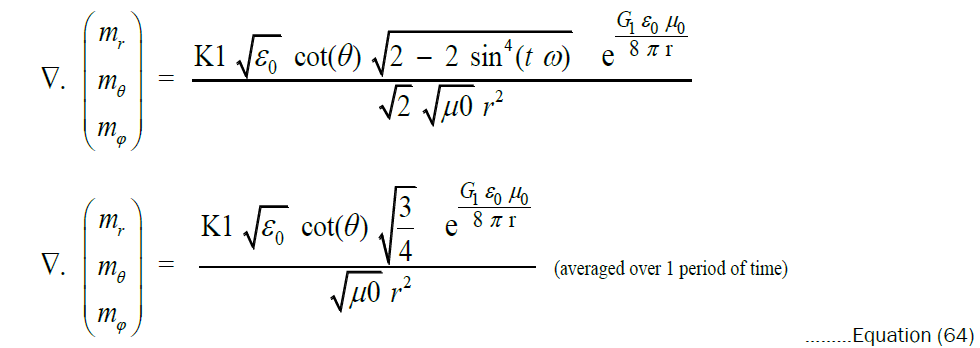
In which K1 is an arbitrary variable. Because of the Cot (θ) function, the electric divergence as well as the magnetic divergence changes from signs when the angle θ varies between 0° until 360° forming electric dipoles (+ versus - ) and magnetic dipoles (N versus S).
GEON with quantum numbers (Electric and Magnetic dipoles, Electric- and Magnetic spin) (m1=1, n1=0, p1=0, q1=0)
The divergence of the electric field intensity (electric charge density) equals:
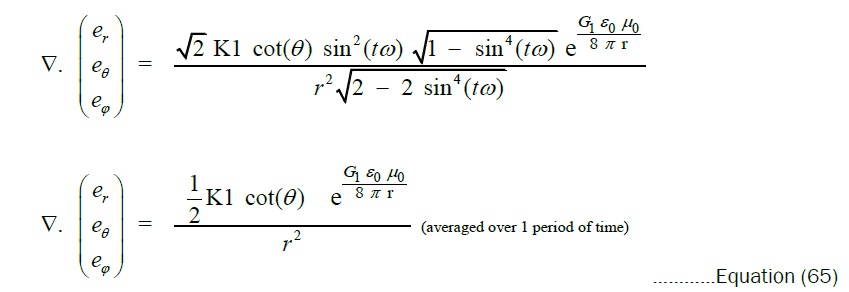
The divergence of the magnetic field intensity (magnetic monopole) equals:
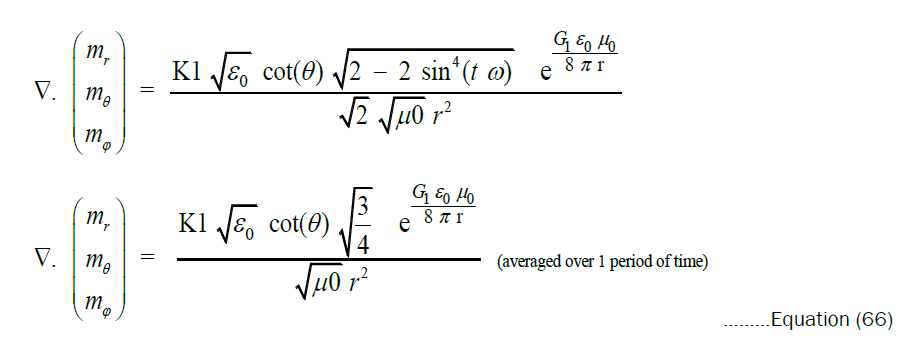
In which K1 is an arbitrary variable. Because of the Cot (θ) function, the electric divergence as well as the magnetic divergence changes from signs when the angle θ varies between 0° until 360° forming electric dipoles (+ versus -) and magnetic dipoles (N versus S).
Gravitational red shift/ blue shift due to electromagnetic gravitational interaction in quantum light theory
The Newtonian equilibrium equation for electromagnetic waves interacting with a gravitational field with acceleration g̅ has been presented in equation (29).

A fundamental solution for equation (57) within a gravitational constant gravitational field g̅ in the z-direction equals for the electric field:
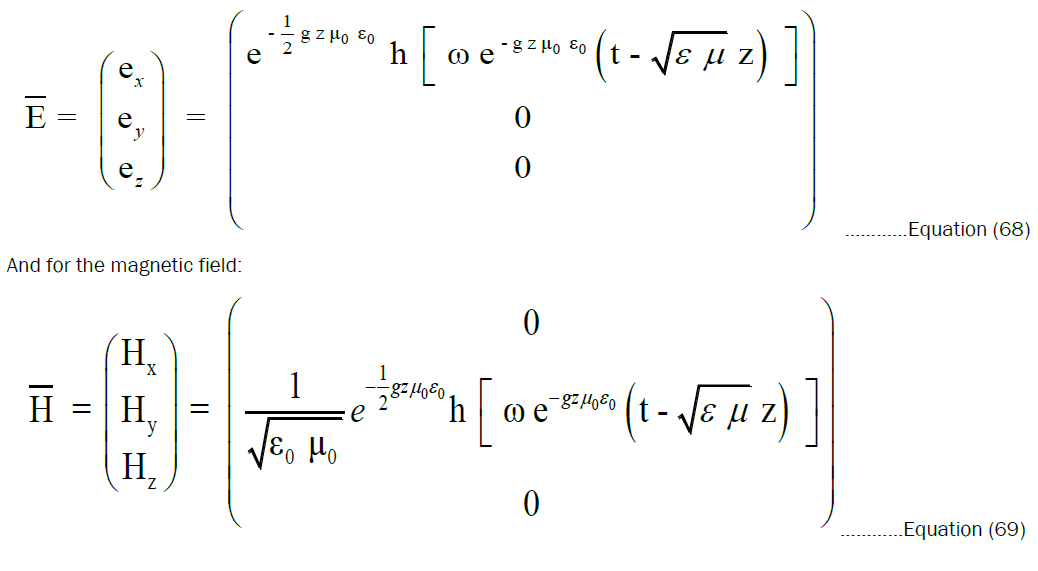
The term  electromagnetic equivalent for Planck’s constant) defines proportionality between the energy density
and the frequency ω. The equations (68) and (69) represent a constant speed of light (C) in which the gravitational
red-shift is equals:
electromagnetic equivalent for Planck’s constant) defines proportionality between the energy density
and the frequency ω. The equations (68) and (69) represent a constant speed of light (C) in which the gravitational
red-shift is equals:

In which ω0 equals the original frequency of the beam of light propagating in the direction of the constant gravitational field in the z-direction and the exponential term demonstrates the gravitational redshift when the beam of light moves away from the gravity source in solar system or black hole. Including the Doppler red shift results in:
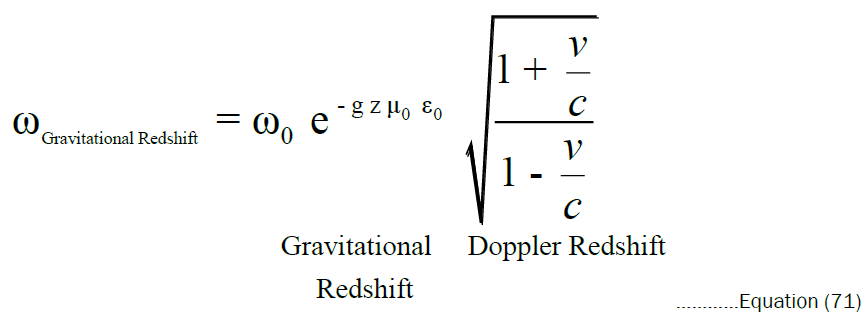
Equation (61) represents the longitudinal gravitational redshift for a constant gravitational field [14]. The Newton electromagnetic equilibrium equation (99) represents possible solutions for all time and space depending gravitational fields and equation (99) is the fundamental equation to be tested relative to Einstein’s theory of general relativity. New measurements of longitudinal gravitational frequency shift (Red-shift) from worldwide observatories could falsify or confirm this new theory [15-17].
For simplicity 3 distinguishments have been made for the different kinds of gravitational fields. The first one is a function with a linear increment to the source of the gravitational field (The center of the Milky Way galaxy to the edge of the Milky Way galaxy) in which the gravitational acceleration “g” and the corresponding solution for equation (99) have been presents in equation (111) . The second gravitational field is proportional to 1/r2 (The gravitational field around the edge of the Milky Way galaxy in which “r” equals the distance. The third type of gravitational field is a constant gravitational field over long distances far away from sources of gravity like black holes [18-20].
Introduction to gravitational redshift
When on earth a ball has been thrown up, the kinetic energy (EM field) has been converted into a potential energy. When a beam of light e.g. laser beam shines up, something comparable happens [21,22]. The EM field Intensity becomes exponentially lower the higher the beam shines upwards but the speed of light does not change. The speed of light remains constant [23-25]. For a laser beam shining downwards on earth, the opposite happens. The intensity becomes exponentially higher and the observed frequency higher blue shift. Equation (111) represents 3 solutions for 3 different kinds of gravitational fields:
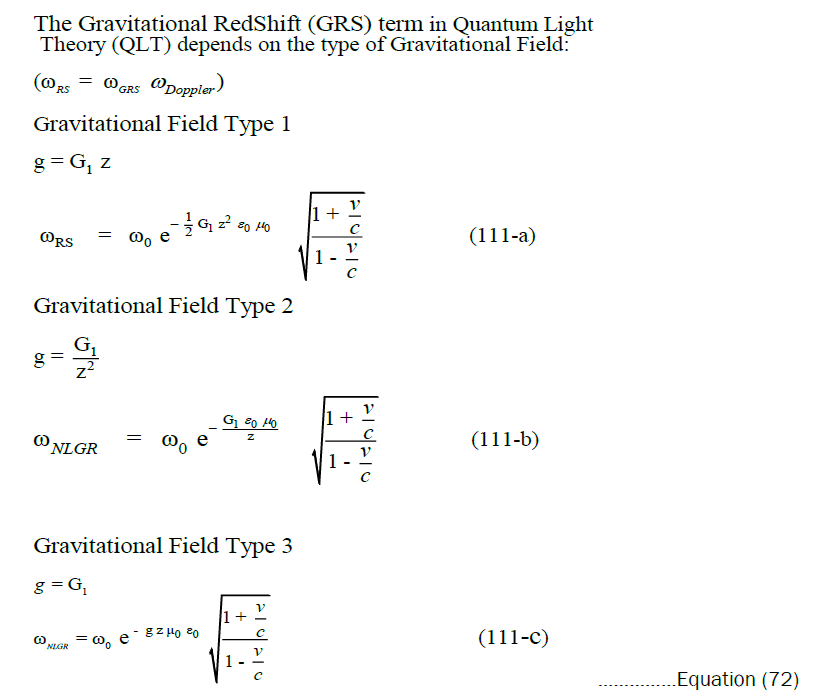
The mathematical solutions for the Gravitational Redshift term in Quantum Light Theory (GRQLT) differ from the Gravitational Redshift in General Relativity (GRGR) with a factor α. Within a constant gravitational field over a distance of 36000 km average satellite height and an estimated gravitational acceleration of g=9.8 ms-2.

The mathematical solutions in (111) and (112) for the gravitational electromagnetic equation (48) on page 29 have been presented in the mathematics 11.0 notebook in example (2, 3 and 4), which can be downloaded from the download page: https://quantumlight.science/
The mathematical solutions for a gravitational field proportional to zn, equation (111) can be presented as:
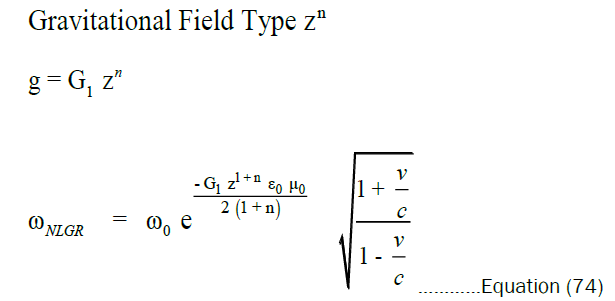
In general equation (111) can be represented as:
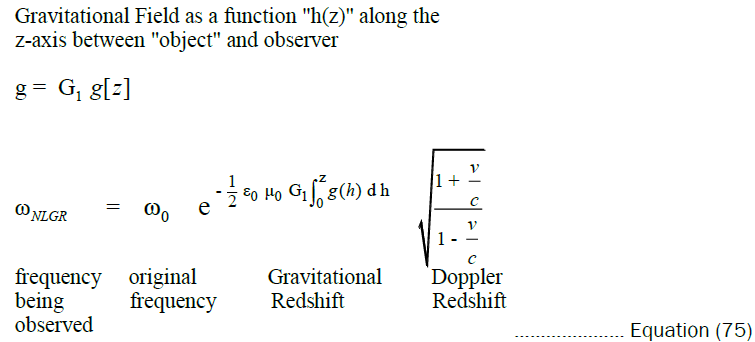
Deviations in gravitational redshift calculated in general relativity and quantum light theory
The mathematical solutions for the Gravitational Redshift term in Quantum Light Theory (GRQLT) differ from the Gravitational Redshift in General Relativity (GRGR) with a factor α.
In general relativity the frequency change in gravitational redshift is proportional to the change of the electromagnetic potential energy U of the radiation [26,27].

Einstein’s theory of “General Relativity” states that clocks at different gravitational potentials tick at different rates, relative to lab coordinates (An effect known as the gravitational red shift).
“General Relativity” and “Quantum Light Theory” are two fundamentally different theories calculating the interaction between gravity and light.
“General Relativity” has been based on a 4-dimensional curvature in space and time due to a gravitational field and light follows the 4-dimensional curvatures in space and time.
“Quantum Light Theory” has been based on a “4-dimensional Equilibrium in Space and Time” presented in the 4-dimensional relativistic Dirac equation (42) expressed by the effects of electromagnetic-gravitational interaction.
An accurate way to test both theories is the “Gravitational Red Shift” within a well-known gravitational field like the gravitational field of the earth. Both theories give different outcomes in the values for the “Gravitational Red Shift” within the gravitational field of the earth between an observatory on earth (Radius=6 × 106 m) and a satellite in a Galileo orbit (Radius=23222 × 106 m). The Galileo space segment comprises a constellation of a total of 30 Medium Earth Orbit (MEO) satellites, of which 3 are spares, in a so-called Walker 27/3/1 constellation.

“Gravitational Red Shift” between an observatory on earth (Radius=6 × 106 m) and a satellite in a Galileo orbit (Radius=23222 × 103 m) according “General Relativity”:
“Gravitational Red Shift” between an observatory on earth (Radius=6х106 m) and a satellite in a Galileo orbit (Radius=23222 × 103 m) according “Quantum Light Theory”:

In “Quantum Light Theory” the result of the calculations has been based on a “Perfect Equilibrium in Space and Time”, taking into account the effect of the change in electromagnetic mass due to the potential energy level. A factor has been defined which presents the measured deviation between the predicted gravitational redshift by general relativity and the measured gravitational redshift.

A comparable factor can be used to determine which theory (GR or QLT) has the closest approach to the experimental data. Highly accurate measuring experiments are required with accuracy higher than 17 digits and experiments with a relative accuracy higher than 8 digits. The required experiments have to be 1000 times more accurate than the accuracy of the measurements presented.
All the Data and all the calculations to provide evidence to “Quantum Light Theory” have been published in the ‘Open Source Framework (OSF)’: https://osf.io/gbn4p/
And the Download Page:https://quantumlight.science/